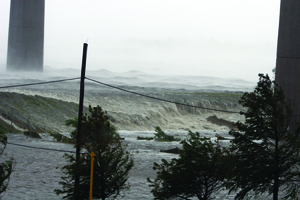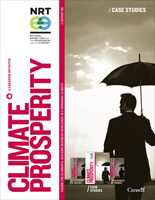Entergy – Case Study
FACING THE ELEMENTS: Building Business Resilience in a Changing Climate
AT A GLANCE // |
Location:New Orleans, Louisiana, USA Industry:Utilities Employees (2010):14,958 Revenue (2010):US$11.49 billion |
Key adaptation
|
Adaptation
|
Business BenefitsReduction of downtime and disruption More robust, resilient economy Capital investment previously diverted to repair infrastructure now can be redeployed to creating wealth for the region Enhance prosperity, safety, and quality of life Stakeholder support or our resilience investments |
COMPANY OVERVIEW //
NEW ORLEANS, LOUISIANA, USA
www.entergy.com

Entergy's Michoud Power Plant, New Orleans,
during Hurricane Katrina
(photo credit: Don McCroskey, Michoud
Plant Manager, Entergy)
ENERGY GENERATION AND DISTRIBUTION IN A CHANGING CLIMATE
Many of Entergy’s assets are located along the Gulf Coast, near areas that are directly exposed to hurricanes or storm surges. The company’s operations are also at risk during heat waves, when access to cooling water for generation facilities is limited.
Storm risks – an example from hurricanes Katrina and Rita
A number of Entergy’s generating stations, several substations, operating centres, customer service centres, IT servers, and its corporate main office were badly affected during two major hurricanes in 2005. The company recorded inundation levels of up to 12 feet (3.6 m) within many of its facilities, and had to dedicate full-time crews to restoring critical company assets damaged as a result. This was in addition to efforts to relocate displaced employees, bring in and house mutual aid crews, and restore electric and natural gas services to its customers. Before Entergy could allow workers to re-enter its damaged facilities, the presence of widespread mould and concerns over potential toxins associated with the floodwaters necessitated a thorough health and safety assessment. Replacing all lost assets and bringing generation, transmission and distribution back online after hurricanes Katrina and Rita in 2005 cost $US1.5 billion.
The Gulf Coast region has 6% of the U.S. population, but accounts for approximately 30% of national GDP.55 Entergy provides service to coastal communities in Louisiana and eastern Texas, and the company is keenly aware that its customers, and the generation, transportation, and distribution systems that serve them, can be heavily impacted by extreme weather events.
Operational risks during heat waves
Low river flows during hot, dry summers can lead to restrictions on water abstractions from local water courses, with consequences for essential cooling at energy generation facilities when the need for cooling is highest. During times of drought, demand for water resources from other parties will also increase, leading to increased competition for a scarce resource in areas where water availability is already constrained. When extreme high temperatures cause spikes in energy demand, power generation systems are likely to be stressed and less able to meet higher demand. The 2011 Texas drought was marked by daily extremes of high temperature. Several electricity plants, not owned and operated by Entergy, were forced to curtail generation during this event (despite record demand for electricity) because of a lack of availability of cooling water. To date Entergy has not had to respond to this kind of impact, but rising temperatures increase the risk of downtime and service disruption to energy supply in the future.
Climate risks to supply chains
Entergy uses a blend of inputs to produce electricity. Natural gas comes from pipelines, while the company’s coal supplies come mostly from the western United States. Although the company has contingency plans, ultimately it is also exposed to the same risks that Entergy’s suppliers face in getting raw inputs to market.
During storm and flood events Entergy’s supply chains and distribution channels are disrupted; this was particularly notable during the Mississippi River flooding in spring 2011. Although the supply chain is robust in that it incorporates several nodes and links to support the distribution system, Entergy has noted spikes in coal and gas prices during widespread flooding events.
Drivers
Hurricanes Katrina and Rita demonstrated the extent to which climate-related events can impact a company’s operations, and galvanized efforts to assess and manage climate risks within Entergy. The utility has since conducted an assessment of climate related risks, and this initiative is continuously updated as part of ongoing risk assessment procedure. The company-wide assessment of climate risks found that a large proportion of facilities are not likely to face significant impacts, and these elements (e.g. the Information Technology department) are being managed separately to concentrate efforts in high-priority risk areas.
A focus on risk and opportunity assessment
The climate risk assessment conducted in the wake of damage suffered during hurricanes Katrina and Rita led Entergy to update its assets to become more resilient against future storm events. The company is also gradually strengthening service delivery and lessening vulnerability by working with community stakeholders and engaging directly with customers on climate change risks.
Entergy’s asset renewal program involves replacing transmission poles near the Gulf to ensure they support higher wind loads associated with more intense hurricanes. Entergy is following a strict policy to strengthen all high risk assets so that as many customers as possible benefit from increased resilience.56 In addition, Entergy monitors its assets closely, and through vegetation management reduces risks that the surrounding environment can present (e.g. windthrow disturbance to power
lines when trees are uprooted or broken during storms). The company has also implemented a program to maintain these assets and prevent environmental damage.
During the storm recovery efforts following hurricanes Katrina and Rita, Entergy hired a disaster preparedness expert to hasten and improve recovery efforts; this position now has a permanent role in the company, with responsibility for improving preparedness for future storm events.
Entergy understands that working with stakeholders can increase resilience to storm events and that those benefits extend to its employees, their families as well as to the surrounding community. The company continuously improves its business continuity plans, and has strengthened the capacity and speed with which it safely restores power to its customers during storm emergencies.
In addition, Entergy and America’s Wetland Foundation (AWF) have collaborated to create Blue Ribbon Resilient Communities (BRRC). This initiative is helping local communities prepare themselves for extreme events and improve their resilience against unanticipated disasters like the recent hurricanes and the BP oil spill. Communities have welcomed these forums, which bring together local government and residents, to assess, analyze and discuss management measures to counter environmental risks along America’s Energy Coast. Through this initiative, communities are better informed and armed with tools to assist in resilience planning to bolster their protection against environmental risks that jeopardize their economic and cultural assets. These communities are benefiting from a stronger regional voice on local issues that call for common-sense solutions to federal policy conflicts and collaborative approaches to sustaining themselves into the future.
The company has learned practical lessons from speaking to customers directly about climate change vulnerability and strategies to build resilience. Through discussion with communities, city managers, county and parish leaders in Texas and Louisiana, Entergy established that power for sewage and water treatment plants was critical during disruptive events. As an adaptation measure in anticipation of further disruption in future, cities have now acquired generators to provide temporary power to water and sewage systems during emergencies. As a result of these discussions, many communities have also begun planning to restore and protect marshlands along the coast to provide added protection against storm surge flood events. This initiative has allowed Entergy and the community it serves to share information and act together to reduce the vulnerability of critical power supply during storm events.
Next steps
America’s Wetland Foundation, Entergy and a diverse group of stakeholders are holding the tenth and final BRRC forum in June, 2012. AWF will compile all of the lessons learned through the initiative into a report, to further raise awareness of climate change impacts and the imperative of improving resilience.
Following the report, AWF is considering an event that would bring together NGOs, communities and government to discuss findings. There seems to be additional value to further collaboration with America’s Wetlands Foundation to strengthen adaptation of the region by focusing on a healthy Mississippi River System. The initiative would bring together the 31 states in the Mississippi River Basin to address policies, challenges and opportunities comprehensively, building on the Gulf Coast adaptation strategies emerging from the “Blue Ribbon” forums.
Entergy is planning to collaborate with representatives from the reinsurance industry, as they are also heavily impacted by climate-related damage. The company has previously partnered with Swiss Re on research programs. The impetus for new collaboration is the exponential increase in insurance premiums for new and existing assets along the coast that are considered at risk due to climate change impacts.
Perspectives on government roles
Entergy’s climate risk assessment initiatives benefit greatly from environmental and climate data provided by NASA, the National Oceanic and Atmospheric Administration (NOAA) the Environmental Protection Agency (EPA) and the U.S. Geological Survey (USGS). In order to proactively tackle climate risks, Entergy and other service providers depend on freely accessible environmental data sets and products. It is more efficient and cost-effective for these data to be collected, updated and shared by government bodies than it is for individual organizations to collect the information they need independently.
Government also has a role to play in revising and promoting building codes (particularly with regard to elevation and extreme events) so that newly built assets are more resilient to climate change.
Local, state and federal government have an important role to play in designing, funding and building integrated “multiple lines” of defence where barrier island restoration, beach renourishment, wetland restoration combined with levy protection and the hardening infrastructure can cost effectively reduce losses and build greater community resilience.57
[55] National Ocean Service NOAA 2011
[56] U.S Department of Energy 2010
[57] Multiple Lines of Defense Strategy ND









































